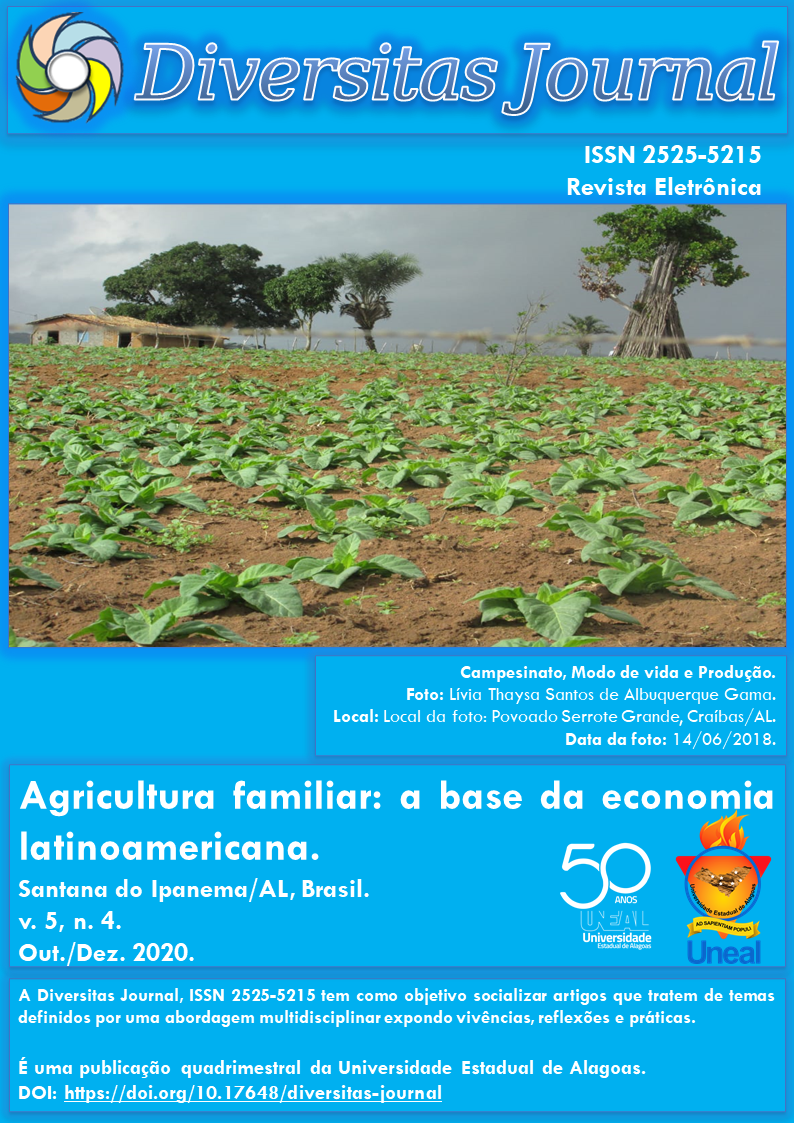Análise fitoquímica e potencial alelopático do extrato etanólico das folhas de Protium calendulinum (Burseraceae) na germinação de Lactuca sativa
DOI:
https://doi.org/10.17648/diversitas-journal-v5i4-1092Abstract
ABSTRACT: Most Protium chemical studies mainly investigate essential oils extracted from the resin. However, there is no information regarding the chemical composition of the leaf extract, and when there are no chemical studies on the species, the phytochemical analysis can identify the relevant secondary metabolite groups. In this context, the aim of the study was to identify the secondary metabolites of the ethanolic extract, obtained from the leaves of Protium calendulinum and to investigate their allelopathic potential on Lactuca sativa. P. calendulinum leaves were collected in July 2019, in the vegetation area of the Federal University of Amazonas - UFAM. To obtain the crude ethanolic extract (CEE), 3 liters of 96% ethyl alcohol on 3 kg of leaves were added. The solution was left to stand for 15 days and subjected to distillation in a rotary evaporator at 70° C. The phytochemical prospecting of the CEE as carried out in a qualitative way. CEE spectrophotometric analyzes were also performed, measured in the range of 240 nm to 700 nm. For the allelopathy test, EB was diluted in the following concentrations: 125 mg/L-1, 250 mg/L-1, 500 mg/L-1 and 1000 mg/L-1. The electrical conductivity of the extract concentrations was determined, and the values used to determine the osmotic potential. The allelopathy bioassay was carried out on L. sativa seeds, 50 seeds were placed in Petri dishes and then added 04 mL of the concentrations. For the negative control, distilled water was used. The allelopathic potential was evaluated by means of the germination percentage, IVG (Germination Speed Index), length of the hypocotyl and radicle. After the test, the chlorophyll and carotenoid assay were performed. To assess the effect of concentrations on percentage of germination; IVG; length of the hypocotyl and length of the radicle, linear regression was used, followed by analysis of variance (Test F). The results obtained in the phytochemical prospecting of the extract of P. calendulinum showed the presence of Flavones, Saponins, Catechins, Phenols and Anthocyanins. Coupled with the results of phytochemical prospecting, the spectrophotometric analysis data confirm the presence of a wide variety of metabolites in the range between 240 and 400 nm. For the osmotic potential, the results obtained varied between -0,0003 MPa and -0,0011 MPa, and are in accordance with the tolerance limit. The results demonstrate that the increased concentration of the extract had a significant effect on germination, IVG, hypocotyl and radicle (p <0.01). This effect corroborates the results of phytochemical prospecting, since flavones and saponins in high concentrations affect the germination percentage, delay the speed with which the seeds germinate and reduce the growth of the hypocotyl and radicle. The levels of chlorophyll b decreased as the CEE concentration increased. The results obtained reveal the presence of different classes of secondary metabolites present in the extract of the leaves of P. calendulinum. And, possibly, due to the presence of these compounds, the extract has a high allelopathic potential, affecting the germination and initial growth of L. sativa, even in low concentrations.
KEYWORDS: Secondary metabolites, allelochemicals, pharmacology.
Metrics
Downloads
Published
How to Cite
Issue
Section
License
Copyright (c) 2020 Andreia Crizostomo Barata, Nicanor Tiago Bueno Antunes, Ruth Crisostomo Paiva, Sâmia Raysa Pinto Nogueira, Jander Savedra Nunes, Odinéia do Socorro Pamplona Freitas

This work is licensed under a Creative Commons Attribution 4.0 International License.
The Diversitas Journal expresses that the articles are the sole responsibility of the Authors, who are familiar with Brazilian and international legislation.
Articles are peer-reviewed and care should be taken to warn of the possible incidence of plagiarism. However, plagiarism is an indisputable action by the authors.
The violation of copyright is a crime, provided for in article 184 of the Brazilian Penal Code: “Art. 184 Violating copyright and related rights: Penalty - detention, from 3 (three) months to 1 (one) year, or fine. § 1 If the violation consists of total or partial reproduction, for the purpose of direct or indirect profit, by any means or process, of intellectual work, interpretation, performance or phonogram, without the express authorization of the author, the performer, the producer , as the case may be, or whoever represents them: Penalty - imprisonment, from 2 (two) to 4 (four) years, and a fine. ”















.png)




